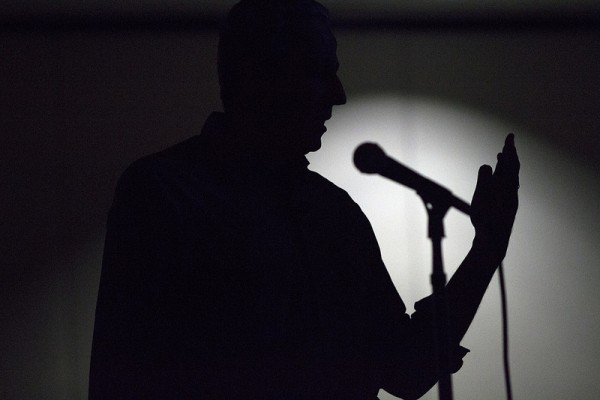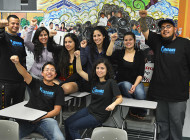“[Advocacy journalism] is always predicated on the idea that we’ll generate awareness and raise interest and support for the victims,” said Ed Kashi.

Documentary photojournalist Ed Kashi gives a presentation at CSUN on his body of work that includes international stories from Nigeria, Northern Ireland, Syria and other hotbed places around the world. Photo: Trevor Stamp / El Nuevo Sol
By JOHN SARINGO-RODRÍGUEZ
EL NUEVO SOL
“A formal education is not necessary to be successful as a photojournalist, but you do need to be educated about the world,” said Ed Kashi to a crowd filled with aspiring journalists.
Nearly 60 people gathered in the Northridge Center, USU at California State University, Northridge on Feb. 3 to attend “A Talk with Ed Kashi.” The event was coordinated and presented by the CSUN Photojournalism Club and the Erlandson Symposium.
Kashi is a world renowned photojournalist, documentarian, multimedia storyteller and activist. He has been a photographer for 35 years.
With his Canon EOS 5D Mark III and an iPhone in hand, he documents his experiences and uses his photographs as a narrative to bring about awareness to human issues like, but not limited to, poverty, displacement and disease; issues that have affected many countries around the world.
Watch the entire event:
“You have to find a project that you’re passionate about, that’s how you keep the flame alive you know? Beyond the struggles of money and the struggles of ego and career and all that. As long as you’re engaged in your work, you’re keeping that flame alive,” said Kashi.
Kashi is a freelance photographer and belongs to VII, a New York based membership agency owned by the photographers that they represent. Kashi’s main magazine client is the National Geographic, for which he has done 17 features for the last 23 years.
Kashi’s work has also been published in The New Yorker and Time magazine. He and his wife Julie Winokur are co-founders of a non-profit multimedia company called Talking Eyes Media where they produce documentary films, multimedia, books and exhibitions that discuss social and political issues.
“[Advocacy journalism] is always predicated on the idea that we’ll generate awareness and raise interest and support for the victims,” Kashi told El Nuevo Sol, “To get people to act and get involved or to get the government to act and get involved.”
Attendees saw a display of Kashi’s photos and multimedia work documenting his time in places like Syria, Nicaragua and Nigeria. In January, Kashi completed his latest work, “Syria’s Lost Generation.” Kashi said that the current civil war has displaced over two million people from their homes and forced them into bordering countries.
While in Jordan and Iraq for two weeks, Kashi found that at least half of the population that has fled Syria are under the age of 18. The psychological and emotional stability of Syria’s exiled youth has been displaced and there has been an increase in mental illness according to Kashi’s site on VII.
“It’s disturbing to see what’s going on. [Syria] was a relatively stable country and it’s disheartening to see the the disruption in these people’s lives. More than that, it potentially feeds the conflict that you create a new generation of Syrians who are disenfranchised, frustrated and angry,” said Kashi.
The last segment of Kashi’s presentation surrounded his book and multimedia story about his relationship with his wife and two children. He says that he finds solace with his family and that without them, he would have gone insane.

Ed Kashi presents his various works to CSUN students and faculty. Photo: Julio Huerta / El Nuevo Sol
The book, titled “Photojournalisms,” documents the toll that his line of work has on his family. The piece weaves together photos that Kashi took with journal entries that he wrote to his wife while he was away for work over a period of nearly 20 years.
When asked if he has ever felt discouraged in his line of work, Kashi said, “I’m discouraged everyday, especially these days because of the changes, the convulsive changes and sometimes it seems like there is no clear path.”
“I have something outside of this crazy life to focus on that has such deep meaning, purpose and hope for the future,” said Kashi.
In addition to his main presentation at the Northridge Center, earlier in the day Kashi spoke to journalism classes and answered questions about his life as a photojournalist and activist.
“Ed Kashi’s attention to human emotion speaks through his work. I didn’t expect a professional with that kind of resume to be so easy to speak to. He is full of knowledge and insight that I found inspiring,” said Joel Paramo, 26, a public relations major.
Although Kashi said that he supports education and appreciates how students at universities like California State University, Northridge are engaged, he believes that factors other than getting an education must come into play in order for one to be successful in the journalism field.
“I owe my success to incredibly hard work, dedication and commitment. To be passionate about what you do and to be willing to take risks,” said Kashi. “I’m always learning about everything, about photography, life, people, myself, it’s constant, that’s one of the exciting things about doing this.”
Every year, the Erlandson International Symposium invites a media professional who has focused on bringing awareness to international issues.
“We decided to invite Ed Kashi because we think that it’s important for students to learn and gain exposure to how photojournalists like [Kashi], an activist, is creating change in society,” said Karla Henry, president of the CSUN Photojournalism Club.
Several departments awarded the CSUN Photojournalism Club the money needed to sponsor the event. The club received a major sum from the Associated Students to help with the speaker fee. The University Student Union, the Journalism and Art Department and the Erlandson fund also contributed.
Tags: Advocacy Journalist documentary Ed Kashi Film John Saringo-Rodríguez photojournalism Social Issues












